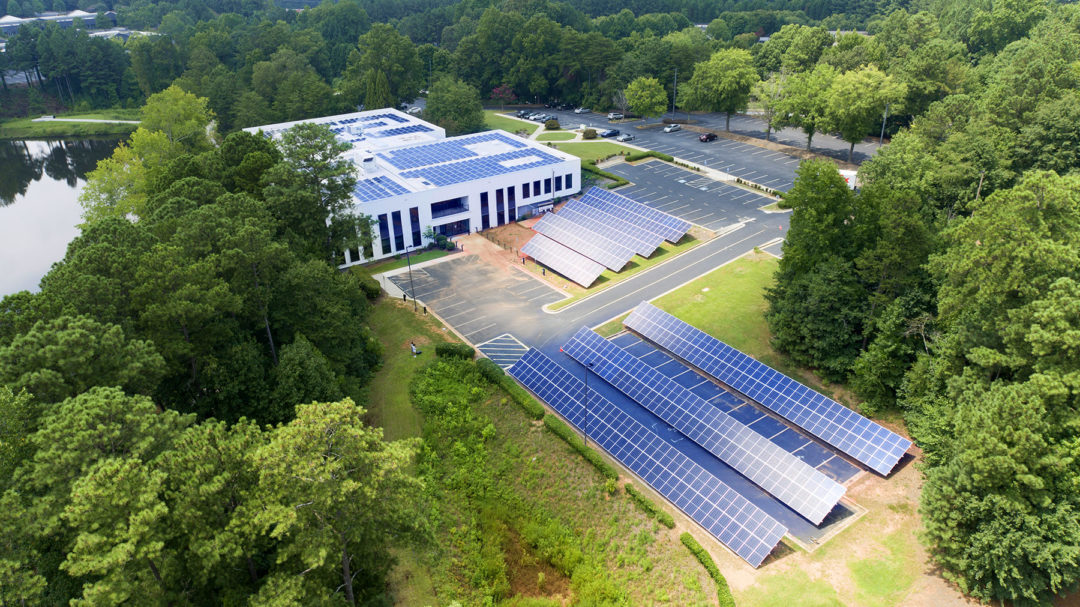Is It Time to Be Hopeful?
We have all the proven solutions we need for the climate change challenges we face.

I’m generally hopeful at the beginning of another year. Sometimes, especially lately, I immediately wonder if my optimism is misplaced. We seem to be leaving the pandemic and some of the economic speed bumps behind, and the future appears to be more promising for construction professionals — even for clean energy evangelists like me.
Will there be new kinds of chaos in the coming year? Or is that foreboding feeling borne of my overexposure to mainstream and social media? I’m never sure. And when I feel uncertain, I take refuge in what I interpret as positive facts, success stories and improving trends.
Consulting firm Deloitte says: “Total construction spending recovered and peaked at $1.57 trillion in July 2021, a record high … and 12 percent higher than 2019 average levels. In a recent survey, 91 percent of [engineering and construction] respondents characterize the business outlook for their industry as somewhat or very positive, 23 percent higher than last year.”
Residential has been outpacing commercial, but that will likely begin to balance out again soon.
And according to the International Energy Agency and Research & Markets, the global air-source heat pump business is growing by about 10 percent per year, including in the United States, where shipments increased from about 2.3 million in 2015 to about 3.4 million in 2020.
Construction and green construction are both likely to benefit from big injections of federal spending on the order of trillions of dollars during the 2030s. As I write this, President Biden has signed the infrastructure stimulus legislation; the White House thinks some form of the Build Back Better package will be passed very soon.
The Semi-Reality of Better-Building Politics
As usual with U.S. federal politics, there has been a lot of dialogue about the pluses, minuses and details of these legislative efforts. However, regardless of the specifics, the general direction is toward more and greener infrastructure and construction activity.
Similarly, on the international stage, November’s COP26 United Nations (UN) summit in Scotland produced some wins and some controversies, but for certain, it confirmed that climate change is now a top issue on the global agenda.
Developments at the UN and in Washington, while often criticized as ineffectual (by me on Twitter!), serve a critical purpose in providing directional leadership or support for millions of people who want action on this issue — including engineers, HVAC and plumbing professionals, architects, urban planners, transportation specialists, energy managers and small governments.
In conjunction with COP26, the United States Conference of Mayors, which represents 1,400 of the largest cities in the country, released a report based on a survey that indicates low energy buildings, solar and electric vehicles are priorities for members. Cities will leverage funds from new national programs and will continue being more aggressive on clean energy than federal and state governments seem to be.
The American Society of Heating, Refrigeration and Air Conditioning Engineers (ASHRAE) hosted a COP26 event related to a communiqué to government leaders challenging them to step up their emissions reduction targets for the built environment. It was signed by large engineering, architecture and construction firms, and organizations representing more than 1 million building industry professionals.
“ASHRAE's climate action efforts exemplify the society’s core dedication to engineering excellence in environmental stewardship,” said ASHRAE President Mick Schwedler. “The ASHRAE global headquarters building renovation project demonstrates that existing buildings can be transformed into net-zero-energy structures cost-effectively, using current off-the-shelf technologies.”
Stories About Real Green Building People
As mentioned, what these people say or do is of some importance, but their stories are less interesting to me than the men and women in the construction industry who actually make things happen. Below is a summary of successes I’ve been collecting, some of which I’ve detailed in this column in the past year or two.
• Atlanta: The aforementioned ASHRAE project is great because it’s a net-zero retrofit using modern heat pumps and ceiling panel delivery, solar, a better building envelope and relatively low-tech ceiling fans.
“We wanted to demonstrate a replicable process for retrofitting a mid-century building to a high-performance building, and show that you can take a leaky building and get it to net zero,” notes mechanical design lead Stanton Stafford of Integral Group.
• Austin, Texas: I seem perpetually to want to write about developer Douglas Gilliland, who is building the 7,500-home Whisper Valley project in Austin. Each back yard has a geothermal well, each roof has solar panels, each garage has EV chargers — and microgrid software connects it all together.
“The adjustments I’ve made as a traditional land developer have not been dramatic,” says Gilliland. “We’re working with five major builders; they’re bringing our green master plan community to market. The changes that we need to make in this industry can be embraced by all developers … all builders, and by all cities.”
• New Haven, Conn.: Architect Bruce Becker founded two nonprofit housing organizations to sponsor innovative mixed-use affordable housing projects and served the community in many other ways.
Recently, he wanted to demonstrate that a Connecticut heritage building, the 165-room Hotel Marcel, could be retrofitted to net-zero with Mitsubishi VRF heat pumps, ERVs, 1,100 solar panels, a better envelope, recycled construction materials, LED lighting and superchargers for electric vehicles. Energy Use Intensity (EUI) is expected to be 34 kBTU/square foot, which is 80 percent less than the median EUI for U.S. hotels.
• New York City and Boston: “Passive House isn’t just for houses,” Lois Arena told me when I was lucky enough to get an interview. “We can go big.” Arena is a senior engineer at Steven Winter Associates and a deeply experienced, highly innovative Passive House veteran.
She led mechanical teams for Sendero Verde, a 699-unit affordable apartment project in East Harlem; a 26-story, 352-unit residence building at Cornell University on Roosevelt Island (pre-fab Passive House); and the world’s biggest, the Passive House office section of Boston’s massive 1.8-million-square-foot Winthrop Center (residential, office, retail space) that will also meet LEED Platinum standards.
There is only one Lois Arena, and she is a sought-after expert and speaker, teaching best practices to building professionals all over the world. She’s also friendly and personable.
• Portland, Ore.: Ben Sturtz, an early clean energy pioneer, demonstrated the merits of Passive House technology at the 57-unit Orchards at Orenco Seniors Residence and other similar developments. In addition, he proudly acquired a grant to fund a building industry open house to show others what could be done.
“I think in the age of climate change, it’s important on many levels not just for the environmental impact and carbon footprint, but for using energy efficiency to bring down the cost of living, especially for people of modest means,” Sturtz notes.
• San Francisco: Larsh Johnson, chief technology officer for Stem Energy, is a smart grid/artificial intelligence trailblazer. Stem is saving a great deal of money for companies all over the United States and around the world, while cutting their greenhouse gas footprints at the same time.
“Our grid has a problem when the sun sets,” Johnson says. “Solar panel production goes down just as power demand ramps up.” Many power utilities charge more for power at certain times of the day, which can be a burden on large multilocation firms.
His company’s battery installations and Athena software solve the problem, using real-time analytics to store energy when it’s inexpensive and discharge it from the battery when grid costs are high. Now clients such as Bed Bath & Beyond, Whole Foods, JC Penney and Extended Stay America are saving hundreds of thousands of dollars on electricity. Because it’s a 10-year lease with Stem, their up-front investment is zero.
• Seattle: Speaking of approachable famous people, Dennis Hayes rose to prominence way back in 1970 as the coordinator for the very first Earth Day. He founded the Earth Day Network and expanded it to more than 180 nations.
More recently, he operates the International Living Future Institute (ILFA), which administers programs such as the Living Building Challenge, a certification that’s even tougher than Passive House. On Earth Day 2013, he opened the Bullitt Center, the ILFI headquarters in Seattle, one of the greenest buildings anywhere. It’s particularly notable for rainwater, greywater and blackwater systems.
In a phone interview a few years ago, Hayes said: “We have a 4- to 6-week supply of drinkable rainwater at any one time. We had to work hard to get local approval and create a compliance path for other buildings. It’s sensible. One of the best resources we have is the seawater that mother nature deposits on our roof. It’s also necessary.
“There are many places like Seattle. It’s getting hotter, and we depend on two reservoirs with declining relative capacity. Climate change is real; it presents enormous implications for the future.”
• Toronto, Ontario, Canada: “This wouldn't be happening if it wasn't for Tim’s model,” said a project manager for a large developer in 2018. Since then, dozens of geothermal fields for medium and large condominiums have sprung up in Ontario and beyond. Developers credit one man with inventing a “utility model” to solve the problem.
“I spent about 10 years trying unsuccessfully to get developers interested in geothermal,” Tim Weber says. “But they did not understand the technology and did not want to increase their capital budgets.”
Finally, a Quebec venture capital firm with experience in renewables agreed to partner with Weber to own and operate geothermal systems for condominiums. They reduced or eliminated developer HVAC capex and created 20-year agreements with condo associations to build, maintain and bill energy services, such as a gas utility.
I could keep adding stories all day about great people in the building industry who know what the world needs to know: We have all the proven solutions we need for the climate change challenges we face.
And now, with the market opportunities, funding, regulations and public support demonstrated by local governments during the U.S. legislative and COP26 struggles, we seem to have some of the other ingredients needed to ramp up our efforts. It’s the beginning of another year, and I’m generally hopeful. I hope you are as well. Happy 2022!





